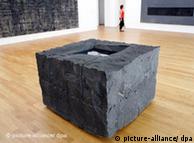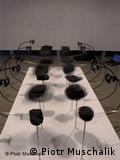艺术史学家Michael Baxandall (1933–2008)去世
2008.08.21
据《独立报》报道:二十世纪下半时期最具影响力的艺术史学家之一Michael Baxandall近日去世。Baxandall曾在意大利的 Pavia大学和德国慕尼黑大学就读。他的作品 The Limewood Sculptors of Renaissance Germany出版后,引起很大反响。此书曾获得艺术史 Mitchell奖。他曾担任 Victoria 和 Albert博物馆建筑和雕塑系的助理监护人, 在那里工作的四年里,他一直致力于德国雕塑的研究。首部作品 Giotto and the Orators出版后,Baxandall 获邀,成为牛津大学的美术教授。1987年,他成为加州大学柏克莱分校艺术史的兼职教授。
Professor Michael Baxandall: Influential art historian with a rigorously cerebral approach to the study of painting and sculpture
Tuesday, 19 August 2008

Michael Baxandall was one of the greatest and most influential art historians of the second half of the 20th century
Change font size:
A | A | A
Michael Baxandall was one of the greatest and most influential art historians of the second half of the 20th century, responsible for the introduction of ideas about language and rhetoric into the study of works of art and a key figure in establishing art history as a subject with its own intellectual rigour.
He was born in Cardiff in 1933 into an upper middle-class family with long connections to museums – his grandfather was Keeper of Scientific Instruments at the Science Museum and his father was Director of the Manchester City Art Galleries and the National Galleries of Scotland. He was educated at Manchester Grammar School and Downing College, Cambridge, where he read English and was much influenced by the works of William Empson and F.R. Leavis, by whom he was taught and who focused his interest on language.
After graduating, he went to study in Italy at the University of Pavia and in Germany at the University of Munich. His book The Limewood Sculptors of Renaissance Germany, published to great acclaim in 1980, was said to have originated in his time as a lonely postgraduate student seeking consolation in the museums of mid-1950s Munich.
On his return to London in 1958, Baxandall was offered a job by Gertrud Bing to work in the Photographic Collection of the Warburg Institute, and, the following year, he was awarded a Junior Research Fellowship at the institute, to study for a PhD on the notion of decorum and restraint in 15th-century Italy, under the supervision of Ernst Gombrich. The Warburg, where he met his wife, Kay, was to remain a spiritual and intellectual home, in spite of the fact that he could be occasionally sardonic about its characteristics and did not fit easily or comfortably into an intellectual school.
In 1961, Baxandall was appointed Assistant Keeper in the Department of Architecture and Sculpture at the Victoria and Albert Museum, where he worked for four years on German sculpture under John Pope-Hennessy as Keeper and, more especially, Terence Hodgkinson, the Deputy Keeper. He was not a natural museum type, but later claimed to like the disciplines of museum life and, slightly idiosyncratically, listed "antiquary" as his profession in his passport.
It was with relief that he was able to retreat to a university lectureship at the Warburg Institute in 1965, where he devoted himself to the research which was supposed to be for a doctorate, but was never submitted and which led to the publication of his first book, Giotto and the Orators, in the Oxford-Warburg series in 1971.
It is hard now to reconstruct the impact which both Giotto and the Orators, a book about how humanists wrote about art, and the immediately subsequent Painting and Experience in Fifteenth-Century Italy (1972), had on the professional study of art history. Up until the early 1970s, most art history had been written from the viewpoint of connoisseurship and attribution, reconstructing the oeuvre of artists from surviving works of art.
Baxandall's approach was rigorously cerebral, studying works of art from the surrounding mental universe, humanist culture in the case of Giotto and the Orators and vernacular culture in Painting and Experience. He was happy to study account books and mathematical manuals and, most of all, books of rhetoric as a way of understanding how artists such as Giotto and Piero della Francesca, as well as their public (the distinction is never clear) viewed their world. The practice of art was viewed as an activity of the intellect at least as much as of the eye.
Following the publication of these two books, Baxandall was established as a major intellectual figure, invited to be Slade Professor of Fine Art in Oxford in 1974, where he lectured on German sculpture. But he resisted categorisation, did not particularly enjoy postgraduate teaching (although he was an inspirational figure to students), and could be wilfully obtuse in his attitude to methodology, as when he was invited by New Literary History to reflect on his approach to the writing of art history. Instead, as art history became increasingly recondite, Baxandall did not like to be associated with a movement towards over-conceptualisation and was an advocate of cool, intellectual rigour in opposition to the more self-consciously learned traditions of the Warburg.
Baxandall's greatest book was The Limewood Sculptors of Renaissance Germany, which won the Mitchell Prize for art history and in which he subjects an unfamiliar field of study to deep, systematic analysis, attentive as always to the relationship between language and form. He was awarded a chair by London University in 1981 and was made a Fellow of the British Academy in 1982, but was increasingly lured away to the United States, where he was appointed A.D. White Professor-at-Large at Cornell University, was given a MacArthur Foundation award, and became a half-time Professor of the History of Art at the University of California, Berkeley in 1987. From this point onwards he led a hybrid life, partly in London, partly in California.
In 1994, Baxandall wrote jointly with Svetlana Alpers Tiepolo and the Pictorial Intelligence and, the following year, under sole authorship, the book Shadows and the Enlightenment. Neither had quite the broad impact of his earlier work, although like all his work, they were the product of systematic and highly original thought.
By now, he was suffering from Parkinson's disease, which clouded the later years of his life, although he bore it with characteristic fortitude and continued to write and publish to the end, including, in 2003, Words for Pictures. It was perhaps this illness, along with his reclusive temperament, that prevented him from receiving the full recognition beyond the scholarly community that the quality of his intellect and the originality of his writing deserved.
Charles Saumarez Smith
Michael David Kighley Baxandall, art historian: born Cardiff 18 August 1933; Junior Research Fellow, Warburg Institute, London University 1959-61, Lecturer in Renaissance Studies 1965-73, Reader in History of the Classical Tradition 1973-81, Professor of History of the Classical Tradition 1981-88; Assistant Keeper, Department of Architecture and Sculpture, Victoria and Albert Museum 1961-65; Slade Professor of Fine Art, Oxford University 1974-75; A.D. White Professor-at-Large, Cornell University 1982-88; FBA 1982; Professor of the History of Art, University of California, Berkeley 1987-96 (Emeritus); married 1963 Kay Simon (one son, one daughter); died London 12 August 2008.
Michael Baxandall, 74, Influential Art Historian, Dies

Kay Baxandall
Michael Baxandall
Published: August 30, 2008
Michael Baxandall, whose analysis of the social forces shaping works of art and the way they were seen helped pave the way for the influential movement known as the new art history, died on Aug. 12 in London. He was 74.
The cause was pneumonia associated with Parkinson’s disease, said his wife, Kathrin Baxandall.
《十五世紀義大利的繪畫和經歷》
Mr. Baxandall’s second book, “Painting and Experience in 15th-Century Italy,” published in 1972, announced a program in its first sentence. “A 15th-century painting is the deposit of a social relationship,” he wrote.
He proceeded to lay bare not only the patron-client transactions that influenced the making of an artwork, but also something he called “the period eye”: the act of perception determined by social circumstances. In a famous example, he showed how Italians knew how to appraise the volume of a barrel by sight, and how artists played to this carefully cultivated skill.
This approach signaled an abrupt departure in art criticism comparable to the shift toward social history among British historians.
“He provided the tools we needed to take works of art out of the frame and off the pedestal to see how they really worked,” said Thomas Crow, a professor of modern art history at the Institute of Fine Arts at New York University. “He made it possible to see, through the art, how societies organized themselves and, conversely, how individuals perceived their own experiences and inner lives.”
Michael David Kighley Baxandall was born in Cardiff, where his father was a curator at the National Museum of Wales. He attended the Manchester Grammar School in England after his father became director of the Manchester City Galleries in 1945, a position that would lead to his appointment as the director of the National Gallery of Scotland in 1952.
Michael Baxandall studied English under the literary critic F. R. Leavis at Downing College, Cambridge, but abandoned plans to teach English and headed for the Continent, where he spent a year at the University of Pavia in Italy. After teaching at a private school in St. Gallen, Switzerland, he went to Munich, where he attended lectures by the art historian Hans Sedlmayr and studied the art of the court of Urbino with Ludwig Heydenreich at the Institute for Art History.
In 1958 he went to London and began a long association with the Warburg Institute, known for its broad approach to cultural history. Initially Mr. Baxandall worked on the institute’s photographic collection. Under Ernst Gombrich, he then began writing a doctoral dissertation, never completed, on an unusual topic: decorum and restraint in Renaissance behavior.
In 1963 he married Kathrin Simon, known as Kay. In addition to his wife, his survivors include their children, Thomas, of Little Tew, England, and Lucy Baxandall of Oxford, England; and two grandchildren.
In 1961 Mr. Baxandall was appointed assistant keeper in the department of architecture and sculpture at the Victoria and Albert Museum, where he worked for four years on German sculpture before returning as a lecturer to the Warburg Institute. There he wrote his first book, “Giotto and the Orators,” on the language that Renaissance humanists used to describe art.
The book, followed a year later by “Painting and Experience in Renaissance Italy,” established him as one of the leading art historians of his generation, a reputation ratified by his next book, “The Limewood Sculptors of Renaissance Germany” (1980). In that work Mr. Baxandall subjected the internal properties of limewood to a detailed analysis that became a metaphor for the social, cultural and religious tensions of the period.
Mr. Baxandall was appointed Slade professor of fine art at Oxford in 1974 and accepted a lectureship at the University of London in 1981. Beginning in the 1980s he taught mostly in the United States, first at Cornell University, where he was a professor at large, and later at the University of California, Berkeley, where he was a professor of art history until his retirement in 1996.
Mr. Baxandall’s other books include “Patterns of Intention: On the Historical Explanation of Pictures” (1985), “Shadows and Enlightenment” (1995) and “Words for Pictures” (2003). With Svetlana Alpers, he also wrote “Tiepolo and the Pictorial Intelligence” (1994).












